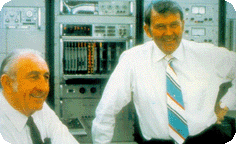A Decade of Large Scale Innovation
In spite of a U.S. recession that created a significant drop in U.S. orders in the early 70s, HP continued its tradition of innovation all through the seventies. Some of these innovations marked the birth of technologies which would stay HP's flagship during the next decades. Automatic microwave network analysis, lazer interferometry, instrument to computer interface bus are some examples, but none of these surpassed the introduction of the HP-35, the world's first handheld scientific calculator, in 1972.
During the 1970-80 decade HP continued its significant growth in earnings, passing the $1 billion sales mark in 1976, and doubling it three years later in 1979.
The company growth in employement is clearly illustrated by the evolution bar chart below:
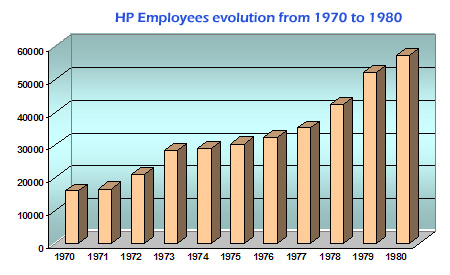 |
| HP Company Data from "The HP Phenomenon" |
 |
Part of a 1976 HP's advertising poster showing
a NASA astronaut using an HP-65.
The world's first magnetic-card-storage, handheld calculator.
Photo Courtesy of Hewlett-Packard Company
|
Another Decade of Space Conquest
Space conquest continued to be a considerable power booster for the American technology evolution during the 1970s.
The four latest Apollo missions: Apollo XIV, XV, XVI, and XVII continued and concluded the moon surface exploration between February 1971 and December 1972.
Skylab was launched in 1973
Apollo-Suyuz, was the first international manned spaceflight in 1975
Viking I and II landed on Mars in 1976
Voyagers I and II headed into the solar system in 1977
As shown on the picture above, after its introduction in 1974, the HP65, world first fully programmable pocket calculator, became a standard tool for every crew of NASA astronauts.
More Info about HP and the Space Conquest
Here is a review of some articles published by the Hewlett Packard Company during that remarkable period of the space conquest. They all reflect the many contributions made by the HP products for the success of this great accomplishment.
1972, Death of the Slide Rule
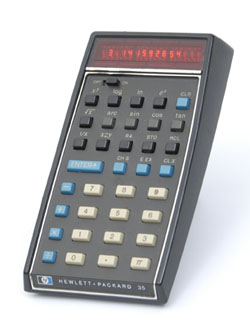 |
HP-35, world's first pocket scientific calculator
|
The HP-35
In 1972, HP introduced the world's first pocket scientific calculator, the HP-35, which soon made the engineer's slide rule obsolete.
Once more, John Minck's narrative is a huge source of information about the HP-35 calculator. John was involved in the marketing of the early HP light-emitting-diode and made a large contribution to the HP-35 project. Four pages, of its "Inside HP narrative", are full of details and anecdotes relative to the HP-35 development stage. Below are three selected paragraphs, but we highly recommend a complete reading of the full chapter:
INSIDE HP: "A narrative history of Hewlett-Packard from 1939-1990"
"In a real sense, the idea for the HP 35 handheld calculator came from a number of sources. Certainly the HP 9100A desktop computer, of 1968, showed the popularity and power of a desktop, technical (personal, not depending on a time-shared mainframe) computer in the hands of engineers. Transistorized desktop adding machines were beginning to take the place of the clacking mechanical "comptometers," built by business machine suppliers like Friden Corp., and others. Japan was building desktop calculators for business use, with Nixie tubes for display. Light-emitting-diode numeric displays had barely been invented."
"The HP 35 was probably HP's number one product winner of its 6 business decades. It captivated our technical customers. It raised HP's already high prestige. It brought untold computing power to the fingertips of the common engineer, and they worshiped HP for the innovation. Finally, it sparked a long succession of more and more powerful machines, the magnetic-strip programmable HP 65, financial versions, and many more."
"The 500-1000 per month forecast for the HP 35 was wildly wrong, on the low side. Sales went through 10,000 per month, climbing almost straight up. The reasons, of course, are clear with hindsight. The price was a stroke of genius, because the $395 was easily within the reach of every engineer, not just managers. It was not only a prestigious personal possession, but an amazing drudgery beater. It made better engineers, and it made them faster and more efficient."
1972, At the Opposite Scale: The HP 3000
At the same time, but poles appart on a size and performance scale, the HP 3000 expanded HP into business computing with this first general-purpose computer. The HP 3000, with its MPE operating system, served high-technology engineering and research needs as well as handling day-to-day data processing and administrative operations inside a company.
Last but not least, the HP 3000 was one of the computer industry's most enduring success stories. More than thirty years after its introduction, its descendant machines were just entering their obsolescent phase at the beginning of the 21th century.
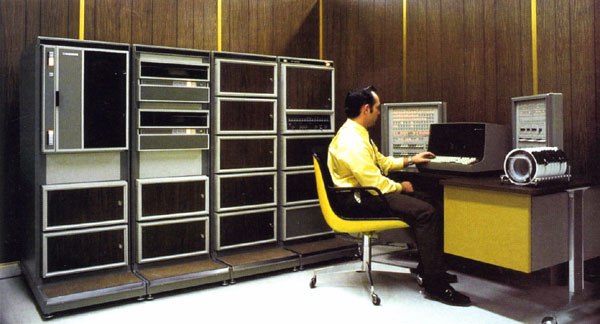 |
from "Wrapping it Up" edition of Measure Magazine
Courtesy of the Hewlett Packard company |
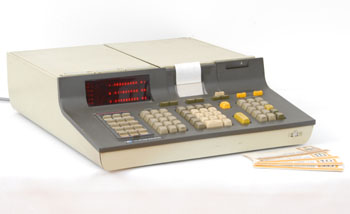 |
HP 9810A Desktop Scientific Calculator
|
1973, Between the two extremes
Between the two extremes, from pocket size to room-sized computers, a second generation of desktop scientific calculators succeeded the very first, the HP 9100A which came out in 1968.
HP's Model 10, Model 20, and Model 30 of the 9800 series were introduced in the December 1972 issue of the Hewlett Packard Journal. The three calculators and many peripherals of the 9800 Series were designed to handle the broadest possible range of applications.
A number of innovations to the desktop computer market, were brought about by the 9800 series . Among them are the following:
- Plug-in, solid-state function ROM on the Model 10
- 16 - character alpha numeric LED display on the Model 20 and 30
- Built-in tape cassette for the Model 30 mass-storage
- Teleprinter-like keyboard and BASIC Programing language on the Model 30
More importantly, the 9800 series desktop computer was the first to integrate a versatile input / output structure to link the computer to a variety of peripherals. This HP internally developed interface bus was the base of the General Purpose Interface Bus (GPIB,) normalized under the IEEE 488 standard.
Detailed information about pocket and desktop calculators of the 70s will be found in a next coming chapter of this Quick Tour.
The best web site, by far, about "The Prehistoric Times" of computers in the Hewlett-Packard company is by Steve Leibson. Steve, gives us an incredibly stylish insight into HP's early computers and the pioneers who developed them.
Interview with the men who brought
the calculator to Hewlett-Packard; By Steve Leibson
Another contribution to the accuracy of the story .
Steve Leibson recently recorded two fabulous video interviews with Dave Cochran and Tom Osborne. These are must-see TV if you enjoy learning about the history of technology.
VIDEO |
 |
|
 |
Early HP-IB compatible instruments and controling computer
Courtesy of Hewlett-Packard Company
|
1975, HP-IB
The HP Interface Bus was first described in the October 1972 issue of the Hewlett-Packard Journal. At the same time Hewlett-Packard began to participate in various national and international standardization bodies to help develop a suitable interface standard. The techniques used by the HP Interface Bus were adopted as an appropriate starting point for a draft document.
Finaly two years later, the Hewlett-Packard Interface Bus had undergone refinements that made it suitable as a model for a proposed international standard: The IEEE 488 Interface Bus.
The January 1975 edition of the Hewlett-Packard Journal gave a complete description of the HP-IB, introducing, by the same way, a quantity of new modular accessories filling in the gaps for automated instrument systems construction.
The HP-IB would became from this time the backbone of every automated system exchanging data between instruments and computers. The majority of instruments developed after 1975, were HP-IB compatible as standard or on option. By the end of the seventies, more than 200 HP instruments were HP-IB compatible, thus giving HP a considerable leadership in the automated electronic systems design. Many HP-IB, interconnected systems, are still in use today in the industry.
1977, Market Diversification, the Great Turn
A very symbolic step in the Hewlett Packard history is illustrated by the bar chart below. The graph comes from the 1977 annual report and clearly shows that for the first time the Electronic Data Products market was equal to the Electronic Test and Measurement Products market at HP. This means that the computer and peripheral sales were the same as the instrument sales for the first time in 1977. Considering that in 1968 the Electronic Data Product market was 4%, and Electronic Test and Measurement Product market was 86%, the least one could say is "things were changing... Fast ".
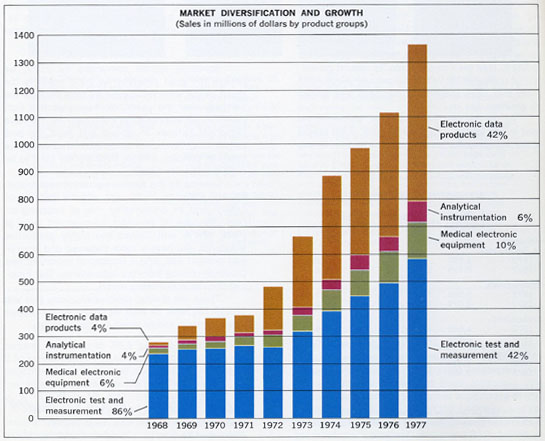 |
from the 1977 Annual Report
Courtesy of the Hewlett Packard company |
1977, John Young Elected President
John A. Young was elected president on November 1, 1977. For the first time, a team of professional managers who were not founder-owners headed the Hewlett Packard Company.
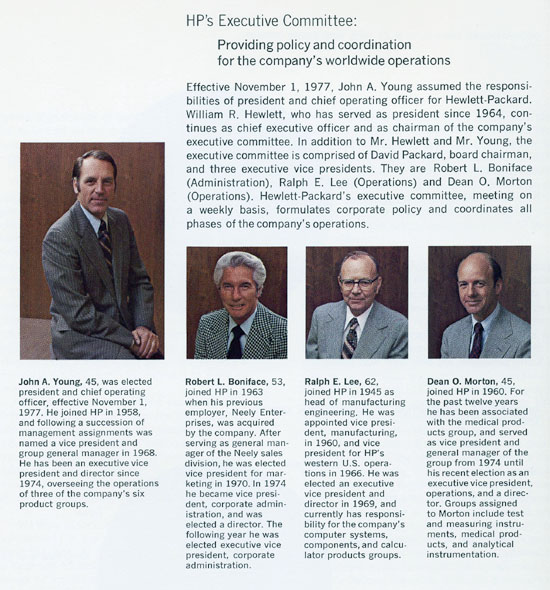 |
HP's, 1977 Executive Committee
from the 1977 Annual Report - Courtesy of the Hewlett Packard company |
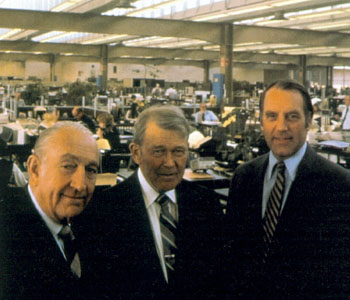 |
Dave Packard ---------------- Bill Hewlett ---------------------- John Young
Photo from Measure Magazine, "Wrapping it UP" Issue
Courtesy of the Hewlett Packard company
|
1978- Bill Hewlett Retired
Bill Hewlett retired on May 19, 1978. John Young, President since the end of 1977, added the C.E.O. title.
But, Bill Hewlett and Dave Packard didn't move far away from the Company head. Bill Hewlett became chairman of the executive committee and Dave Packard was still chairman of the board.
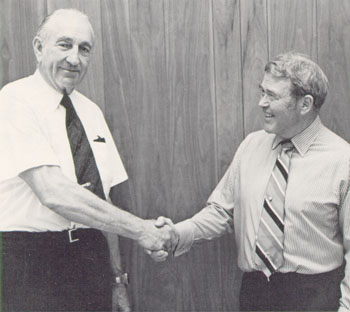 |
"A GOOD FORTY YEARS..."
Dave Packard and Bill Hewlett mark 40 years of
Hewlett-Packard service with a handshake
Photo from Measure Magazine, January 1979
Courtesy of Hewlett-Packard Company
|
1979, Fortieth Anniversary of the Founding of the Company
From the 1979 Annual Report:
INTRODUCTION TO HEWLETT-PACKARD'S
CORPORATE OBJECTIVES
"1979 marked the fortieth anniversary of the founding of the Hewlett-Packard Company. It was also 40 years ago that the founders formulated many of the management concepts, later to become the corporate objectives, that have shaped the company and guided its growth. The objectives were first put into writing in 1957. They have been modified from time to time (most recently in 1977) to reflect the changing nature of the company's business and the environment in which HP operates. Even so, the essence and intent of today's objectives remain remarkably similar to the original versions.
For this anniversary year, the objectives have been selected as the framework for HP's customary review of its operations."
A Review of Other Anniversaries of the Founding of the Company
As in any close-knit family, celebrating anniversaries was a respected tradition at HP. Even more than in a family, there were many reasons to celebrate events within such a thriving company. The decennial event celebrations were especially valuable for looking back at the continuing success and growth of the company during that elapsed 10-year period.
1939-2009 |
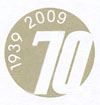 |
|
1979, The HP WAY Updated
From the 1979 Annual Report: NEW DEFINITION OF THE HEWLETT-PACKARD'S CORPORATE OBJECTIVES
1. Profit, To achieve sufficient profit to finance our company growth and to provide the resources we need to achieve our other corporate objectives.
2. Customers. To provide products and services of the greatest possible value to our customers, thereby gaining and holding their respect and loyalty.
3. Fields of Interest. To enter new fields only when the ideas we have, together with our technical, manufacturing, and marketing skills, assure that we can make a needed and profitable contribution to the field.
4. Growth. To let our growth be limited only by our profits and our ability to develop and produce technical products that satisfy real customers needs.
5. Our People. To help HP people share in the company's success, which they make possible; to provide job security based on their performance; to recognize their individual achievements; and to help them gain a sense of satisfaction and accomplishment from their work.
6. Management . To foster initiative and creativity by allowing the individual great freedom of action in attaining well-defined objectives.
7. Citizenship. To honor our obligations to society by being an economic, intellectual and social asset to each nation and each community in which we operate.
 |
Cover of the 1979 Annual Report
Courtesy of the Hewlett Packard company |


